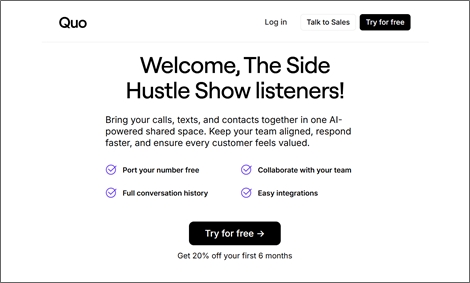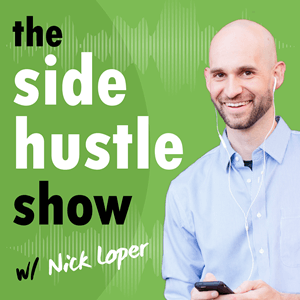
Let me tell you about the side hustle I wouldn’t have believed if I hadn’t seen it myself.
Jeff Rose from Good Financial Sense is earning over $1,000 per day by posting content on Facebook. And a lot of it is just screenshots of other people’s tweets.
He cracked the code of Facebook’s content monetization program, where the platform pays creators to keep users engaged.
The more time you spend scrolling, the more advertising dollars Facebook makes — and they’re sharing that revenue with content creators like Jeff.
In this episode, Jeff pulls back the curtain on exactly how he built this income stream in less than a year, working just a few hours per week.
Tune in to Episode 706 of the Side Hustle Show to learn:
- How Jeff accidentally stumbled upon this opportunity and made $137 from his first viral post
- Setting up Facebook monetization and getting invited to the program
- Where to find content ideas and what performs best
- The tools Jeff uses to schedule a week’s worth of posts in just a few hours
Sponsors
- Mint Mobile — Cut your wireless bill to $15 a month!
- Indeed – Start hiring NOW with a $75 sponsored job credit to upgrade your job post!
- Quo (formerly OpenPhone) — Get 20% off of your first 6 months!

- Shopify — Sign up for a $1 per month trial!
Stumbled Upon It By Accident
Jeff’s journey into Facebook monetization started with a joke.
He had been posting one to two reels per day on Instagram, and some of them were getting cross-posted to Facebook. One reel ended up getting several hundred thousand views on Facebook — way more than it got on Instagram.
But the real “aha moment” came in May or June of 2024.

He found a hilarious tweet about someone ordering an empty McDonald’s box through DoorDash. The guy literally ordered a Big Mac with no bun, no meat, no toppings — just to see what would happen.
Jeff thought it was funny, took a screenshot, and posted it to his Facebook page.
The next month, he logged in and discovered Facebook was going to pay him $137 for that one post.
His second big post came shortly after: a high school picture of Taylor Swift with her ex-boyfriend. He found it on X (formerly Twitter), shared it to Facebook, and made over $500.

Neither post was directly related to personal finance (Jeff’s main niche), but they both went viral. And Facebook rewarded him for the engagement.
Setting Up Facebook Monetization
Here’s what you need to know about getting started with Facebook’s content monetization program:
It’s invite-only. There’s no application process like YouTube’s partner program with specific subscriber counts or watch hours.
Facebook looks at your page activity and sends an invitation when they think you’re ready.
If you already have an established Facebook page with followers, there’s a good chance you’re already eligible. You just need to turn it on and submit your payment information.
For newer pages, Facebook will show you goals and milestones to hit, like posting a certain number of times per week or publishing reels. Hit those targets consistently, and you’ll likely get invited.
Jeff’s page had around 30,000 followers when he started, but it had been mostly dormant. Once he started posting consistently (eight times per day), that’s when things took off.
One cool feature Jeff discovered: Facebook’s analytics now show you how many new followers you gained from each specific post. This helps you identify which content is really resonating and bringing in new audience members.
What to Post and Where to Find Content Ideas
Jeff tests everything. Looking at his page, you’ll see a mix of content:
Screenshots From Other Platforms.
Jeff finds viral content on X (Twitter) or Threads and reposts it to Facebook. Sometimes it’s finance-related (like stock market charts), sometimes it’s completely random (like that DoorDash story). If it got engagement elsewhere, it might work on Facebook too.
Personal Finance Topics
Posts about gold, Bitcoin, the S&P 500, or stock picks tend to resonate with his audience.
Broader Lifestyle Content
Marriage humor, parenting stories, and relatable everyday content also perform well — even on a finance-focused page.
“The weird thing is not everything hits,” Jeff admitted. He’s posted content he spent time crafting with ChatGPT that completely flopped, while random screenshots brought in hundreds of dollars.
The key is volume and testing. Post consistently, track what works, and double down on those topics.
Where to Source Content
Jeff’s main strategy is finding viral content on other platforms and adapting it for Facebook. His go-to sources are:
- X (formerly Twitter). This is Jeff’s primary content mine. He looks for tweets that have already gone viral (hundreds of thousands of views) and takes screenshots to post on Facebook.
- Facebook itself. Jeff scrolls his own Facebook feed looking for posts from other pages that are going viral. If it’s working for someone else in a similar niche, it might work for him too.
- Threads. Jeff uses Threads as a testing ground. He’ll post something there first to see if it gets engagement before bringing it to Facebook.
Here’s Jeff’s secret for never running out of ideas: Train the algorithm to feed you content.
When he’s scrolling Facebook or X, he likes and bookmarks any post that went viral. Facebook then starts showing him more of that type of content.
He saves these posts into folders by category (finance, parenting, marriage, etc.), so when it’s time to schedule content, he has a backlog of proven ideas.
“Once you engage in the algorithm, it’s automatically feeding you new ideas constantly that already have social proof,” Jeff explained.
One clever hack: When you find a viral post, click into the comments. If a comment also got a ton of likes, you can rewrite that as your caption. You’re doubling down on proven engagement.
How Jeff Got His Initial Traction
Jeff didn’t see serious income until he committed to posting at least eight times per day.
Before that, he was posting once or twice a week and the page was mostly dormant. Once he hit eight posts per day, his income and views started trending upward.
From there, he scaled up to 12, then 16, then 20, then even tried 31 posts per day (which was too much). Now he’s settled at around 20 posts per day, which seems to be the sweet spot for him.
Do you need to post 20 times a day to get started? No.
If you’re just starting out, aim for 5 to 8 posts per day. Mix it up with text posts, images, and reels. Test different content types and see what resonates.
Jeff also emphasized the importance of consistency. Facebook wants to see that you’re committed to the platform. Sporadic posting won’t cut it.
Is It Worth It to Boost Posts?
Jeff hasn’t personally tested boosting posts with ad spend, but he follows someone who specializes in Facebook monetization who has a specific strategy.
The recommendation: boost posts at the end of their life cycle.
When a post starts taking off and trending, let it run naturally. Once you see it start to die down and it’s exhausted its organic reach, that’s when you might want to boost it.
The goal isn’t necessarily to increase revenue from that one post, but to grow your following. If a post already performed well organically and gained you followers, boosting it could help you reach even more people.
Jeff was organically gaining 20,000 to 30,000 new followers per month, so he hasn’t felt the need to test paid boosting yet. But it’s something he plans to experiment with in the future.
Tools and Tech
Jeff doesn’t have a virtual assistant. He does this all himself in about four hours per day, two days per week (Mondays and Tuesdays).
Here’s his workflow:
- Buffer – His main scheduling tool. He sets up predetermined posting times, then just adds content to the queue. Buffer also lets him add a “first comment” automatically, which helps boost engagement.
- Post Planner – Jeff is testing this as well, mainly for its research tool that helps find trending content.
- ChatGPT – Jeff uploads screenshots to ChatGPT and asks for caption ideas. ChatGPT gives him multiple options: thought leadership version, satirical version, snarky version, etc.
- Canva – When he wants to add his branding to a screenshot, he throws it in Canva with his logo and a headline.
Related: Ways to Make Money Using Canva
Jeff’s process looks like this:
- Find viral content on X, Threads, or Facebook
- Take a screenshot or save the image
- Upload to Buffer as a draft
- Later, batch-write captions and first comments using ChatGPT
- Schedule everything out for the week
He posts about 20 times per day. Some are text posts, some are images, some are reels. Variety matters.
And here’s a pro tip: Jeff can recycle content. He’ll repost something from 60 to 90 days ago. Sometimes a post that flopped the first time does great the second time (or vice versa). Timing matters.
Story-Based Content and Testing Formats
People love stories, Jeff emphasized. Story-based content tends to perform well because it’s more shareable.
Why do people share content? To improve their status. If sharing something makes them look smart, funny, or like they’re “in the know,” they’ll share it.
Jeff also tests different formats. If he has an image that performed well as a regular post, he’ll upload the same content as a reel. Reels tend to reach non-followers more easily, so this can help grow your audience even more.
The key is testing everything and watching the analytics to see what sticks.
Different Revenue Streams
Right now, Facebook monetization is Jeff’s main focus. But he’s exploring ways to layer on additional revenue streams:
- Affiliate marketing. Jeff hasn’t pushed this hard yet, but with his growing following and engagement, promoting affiliate offers could work well.
- Email list building. Jeff experimented with sending his email list to Facebook posts to boost early engagement. This signals to Facebook that the content is valuable and helps it get shown to more people.
- Course sales. Jeff created Get Paid to Post, a course teaching others how to replicate his Facebook monetization success.
- Sponsorships. Jeff does some sponsored posts, though they typically don’t get as much organic reach. Sponsors often run ads to boost the visibility of those posts.
The beauty of Facebook monetization is that it’s pretty hands-off. You’re not trying to sell anything in your posts. You’re just getting paid for engagement and views.
A Day in the Life
Jeff spends about four hours per day, two days per week (usually Mondays and Tuesdays) scheduling content for the entire week.
He’ll spend some of that time scrolling X and Facebook, bookmarking viral content. Then he uploads everything to Buffer as drafts. Later, he’ll sit down with ChatGPT and batch-write captions and first comments for everything.
He schedules about a week’s worth of content at a time. The most he’s ever been ahead is about two weeks.
During the week, Jeff will occasionally jump in to post something timely or respond to comments, but for the most part, everything runs on autopilot once it’s scheduled.
Mistakes and Surprises Along the Way
Jeff’s biggest surprise was the realization that screenshots of other people’s content can make serious money.
His most shocking example: He found a post on X where a creator shared their monthly payout from X: $300 for posting multiple times per day all month.
That same post happened to have a reply from Elon Musk, which made it go viral.
Jeff took a screenshot of the tweet, posted it to his Facebook page, and made $1,200 from that single post.
The original creator made $300 for an entire month of posting. Jeff made $1,200 from one screenshot.
“I almost feel guilty,” Jeff said. “But it was like, whoa, okay.”
This perfectly illustrates why Facebook pays better than most other platforms right now. Facebook is heavily investing in keeping users on the platform, and they’re willing to pay creators to make that happen.
What’s Next for Jeff?
Jeff is excited to teach others how to replicate his success.
To put this in perspective: The best three-month stretch Jeff had on YouTube was during COVID, when he made about $35,000 over 90 days. He was all-in on YouTube back then — scripting, filming, editing, managing 350,000 subscribers.
He made more than that in one month on Facebook with way less effort.
“The time spent, it just doesn’t — the math doesn’t math in my brain,” Jeff said.
He created a course called Get Paid to Post to show people exactly how he’s doing it.
The course includes done-for-you templates, workflows, and real-life case studies.
Jeff’s #1 Tip for Side Hustle Nation
“Turning on Professional mode is Step 1.”
Episode Links
- Good Financial Sense
- Good Financial Sense on Facebook
- Get Paid to Post
- Facebook’s content monetization program
- X (formerly Twitter)
- Threads
- Buffer
- Post Planner
- ChatGPT
- Canva
- Elon Musk
Looking for More Side Hustle Help?
- Start Your Free $500 Challenge. My free 5-day email course shows you how to add $500 to your bottom line.
- Join the free Side Hustle Nation Community. The free Facebook group is the best place to connect with other side hustlers and get your questions answered.
- Download The Side Hustle Show. My free podcast shares how to make extra money with actionable weekly episodes.














Thanks for having me on!
You rocked it, thanks for joining me!